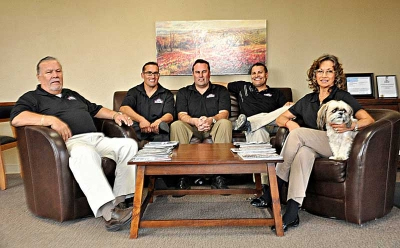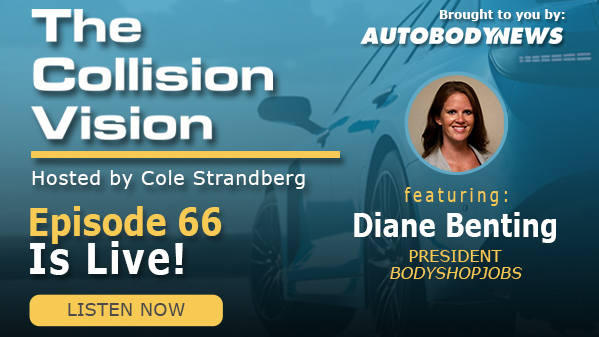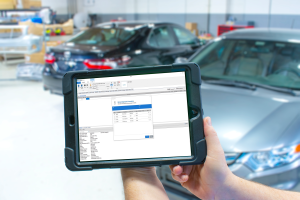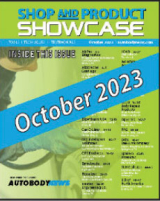In 1956, Bruno Sanchez opened a 2,500-square foot auto body shop in San Francisco, CA. He named it Bruno and Son Auto Body Shop and the goal was to offer honesty, passion and craftsmanship.
Over the years, the family business grew and was eventually renamed B&S Hacienda Auto Body. Currently owned and operated by David and Maria Dolores and their three sons, David Jr., Tony and Rob, the company has expanded to include six locations in the Tri-Valley Area of California.
David Jr., CFO of B&S Hacienda, said the Sanchez family has always been committed to providing excellent customer service and quality repair work.
The team recently developed software, called Kustomine, designed to empower body shops with a paperless customer experience that reduces environmental impact, saves time and money, and provides cleaner data for the tools used to run the body shop.
Autobody News reached out to David Sanchez Jr. and Jeff Hill, an information technology (IT) consultant who helped develop the product, to find out more about Kustomine and what led the team to create the solution for the collision repair industry.
Can you share some history about B&S Hacienda Auto Body?
David: My dad, who is also named David, worked in my grandfather’s shop growing up. He began running it in 1968 and eventually purchased the business in 1980. After opening a second location in Pleasanton in 1991, he changed the name to B&S Hacienda Auto Body to reflect a partnership the company had with a nearby collision repair facility.
In 1956, Bruno Sanchez opened Bruno and Son Auto Body Shop.
We recently celebrated our 30th anniversary of that location. The original San Francisco shop was eventually sold in 1994.
My brother Tony, the general manager, started working with my father in 1992. Rob, vice president of dealer relations, joined in 1993. After earning a business degree at Chico State, I came onboard in 1999.
Since my grandfather established the first location 65 years ago, we have opened six shops in the Tri-Valley area of California: Dublin, Livermore Southfront Road, Livermore First Street, Pleasanton Old Santa Rita, Pleasanton California Avenue and San Ramon.
My parents are semi-retired but still come by the shops. They spend most of their time doing philanthropy work, which they absolutely love.
What prompted the company to develop Kustomine software for the collision repair industry?
Jeff: I grew up in the same neighborhood as David, Tony and Robbie and we had been trying to work together for years. Finally, in 2019, B&S engaged my company to build a better way to connect with customers from the time they initially drop off their car through to the delivery process—from quote to cash. Ultimately, we figured out how to improve this process using modern web development architecture and communication methods such as texting and email.
David Sanchez, CFO of B&S Hacienda Auto Body, provides a customer with a tablet that uses Kustomine software.
Can you provide an overview of the software?
Jeff: When customers come in for an estimate, they are handed a tablet, iPad or Surface computer to input basic personal information. Then, the CSR or estimator takes pictures of the damage and sends the information to the application, which we call Kustomine. Customers immediately receive a welcome message via email or text, as well as information regarding their insurance policy and rights. The estimate is also created automatically.
The solution allows us to take estimate data virtually in real-time and push it to the custom CRM application. The software provides a 360-degree view of the repair so a customer can stay updated about everything concerning their vehicle. It also allows us to remarket to our customer base effectively.
How is it currently being used and what has the reaction been from customers and employees?
David: We rolled out the product to our flagship location in Pleasanton in December of 2019. Once we realized how successful it was, we began using it in the rest of our locations. We’ve found that it has led to a drastic increase in customer engagement.
During COVID-19, we tried landing every person who came through the door. The product helped us do that with the welcome email/text and providing information about their rights.
Jeff: In regard to employees, most of those on the front lines, including the CSRs and estimators, are at least a generation younger than us. Their comfort level with this type of technology is very high and they welcomed it with open arms.
B&S Hacienda Auto Body in Pleasanton Old Santa Rita.
Who is your target market?
David: Kustomine was designed for shops looking for change and/or better processes. This includes single, independent shops as well as giant MSOs.
We feel that the product has great potential for the industry. We’re gearing up to launch our public beta of the cloud-based product on Sept. 1.
We’re hoping to have a short beta cycle and launch version one of Kustomine by the end of the year so we’re ready for anyone who wants to sign up and buy a beta license. As a small company, we look forward to people’s input and find out how to make this worthwhile for everybody.
What are some of the benefits for auto body shops using Kustomine?
Jeff: Kustomine securely stores all of the documentation pertaining to the repair and generates reports that are useful for growing the business. For example, you can reach all of your customers who own a certain car brand and do individual outreach. All of the information is stored on an encrypted database and travels across a secure SSL channel.
Based on this information, we can create targeted communication to reach potential and current customers and focus on process improvement. For example, we’ve been able to shorten the amount of time that needs to be spent on an estimate by figuring out how long it will be between first notice of loss (FNOL) and when an estimate is turned into a work order. We can track all of those metrics and figure out which ones take the longest.
David: One of the biggest benefits is the elimination of unnecessary waste. I think that our industry does enough wasting and we wanted to address that. With Kustomine, we created a paperless, seamless process that essentially eliminated the use of paper. This is especially relevant since the pandemic.
Also, shops receive 100% clean data because customers are entering it themselves. We often receive the wrong email address due to a keystroke error from the estimator or a language barrier between the customer and CSR. Through the use of this tool, we know we’ll have accurate information.
In our industry, a shop typically writes an estimate and if the customer leaves, you’re more than likely not going to get the job. By touching a customer immediately and sending them useful information, we have found the capture rate is greater because of the instant communication.
Nine times out of 10, it’s a customer’s first accident in seven years. Things change over time and people need to know their rights, including that they can go to the shop of their choice. We ensure they receive that information immediately.
We are an OEM-centric company that takes pride in being part of more than 10 OEM certification programs. Once we communicate that to potential customers, I believe it helps them decide to have their car repaired in one of our shops.
What is the importance of being OEM certified?
David: Without a doubt, it’s the best way to fix a vehicle. With cars being more advanced and complex to repair, it’s essential to do your pre-crash analysis and calibration and understand what you are fixing. In our opinion, the OEM data is priceless.
We do a lot of research and documentation to make sure we are repairing vehicles properly and putting them back to the OEM’s specifications. Although it can be a significant expense, we are willing to pay for it. There are too many things that could go wrong in the vehicle you are working on. Our job is to make our customers safe with every repair. This is going to become even more important in the future.
What type of philanthropy and community service does your family take part in?
David: My parents are very passionate about community service and instilled it in us. They have been key members of the Pleasanton Lion’s Club for at least 30 years. Although it is a small group, they do a tremendous amount of work in this area.
My mom also supports the Juvenile Diabetes Research Foundation, a global organization that funds Type 1 diabetes research.
One of the organizations near and dear to my heart is Sunflower Hill, which is dedicated to creating places where adults with intellectual and developmental disabilities, including autism, live and work. I have an employee and a friend who both have children with autism and I’m thankful that my wife and I can support that organization.
We are also involved with the College is Real program, where we donate and assist underprivileged children apply to, attend and graduate from college. Some are the first kids in their families to earn their college education.
Our family believes in philanthropy and loves to give back to the community where we grew up. We’ve been blessed with good fortune and want to give back.










Stacey Phillips Ronak